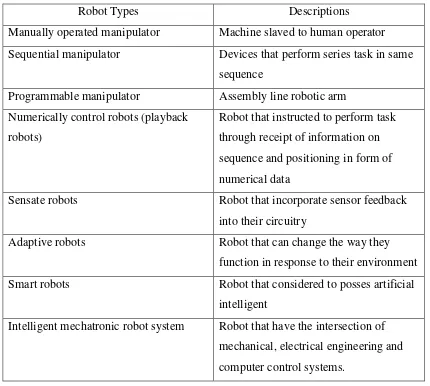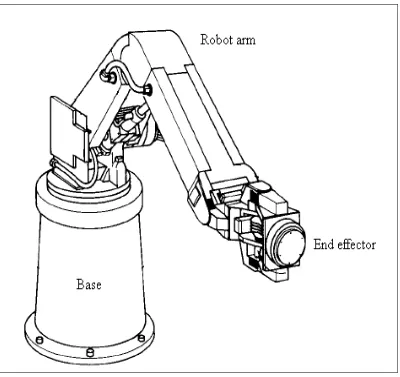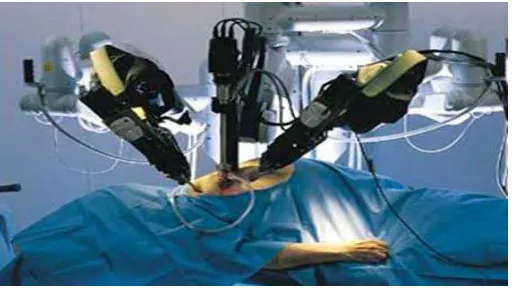DESIGN THE LINE FOLLOW ROBOT SORTING MECHANISM USING
PLC
MOHD SHAZWI BIN MOHD SHARIF
DESIGN THE LINE FOLLOW ROBOT SORTING MECHANISM USING PLC
MOHD SHAZWI BIN MOHD SHARIF
This Report Is Submitted In Partial Fulfillment Of Requirements For The Degree of Bachelor In Electrical Engineering (Control, Instrumentation & Automation)
Fakulti Kejuruteraan Elektrik
Kolej Universiti Teknikal Kebangsaan Malaysia
“I hereby declared that I have read through this report and found that it has comply the partial fulfillment for awarding the degree of Bachelor of Electrical Engineering
(Control, Instrumentation & Automation)”
Signature : ……….
Supervisor’s Name : MR. AHMAD AIZAN BIN ZULKEFLE
“I hereby declared that this report is a result of my own work except for the excerpts that have been cited clearly in the references.”
Signature : ………
ACKNOWLEDGEMENT
ABSTRACT
ABSTRAK
TABLE OF CONTENTS
CHAPTER EVENT PAGE
1 2 SUPERVISOR DECLARATION PROJECT TITLE DECLARATION DEDICATION ACKNOWLEDGEMENT ABSTRACT ABSTRAK CONTENT
LIST OF FIGURE LIST OF TABLE
i ii iii iv v vi vii xi xiii INTRODUCTION 1.1 Problem Statement 1.2 Objective
1.3 Scope of the Project 1.4 Project Overview
LITERATURE REVIEW 2.1 Robots
2.1.1 Robots Architecture 2.1.2 Robots Application
2.1.2.1 Robots at home 2.1.2.2 Telerobots 2.1.2.3 Military robot 2.1.2.4 Mobile Robot
2.2 Mobile robot using line tracking 2.2.1 The main parts of mobile robot 2.2.2 Sensors
2.2.3 Type of Photo-electric Sensors 2.2.3.1 Thru-Beam
2.2.3.2 Reflex/Reflective 2.2.3.3 Polarized/Polarizing 2.2.3.4 Retro-Reflective 2.2.3.5 Diffuse
2.2.3.6 Fiber-Optic Sensor
2.2.3.7 Electronic Field Sensors (Proximity Sensor) 2.2.3.8 How to choose between limit switch, proximity sensor and photo-electric sensor 2.3 Controller
2.3.1 Programmable logic controller 2.3.2 Micro-controller
2.3.3Micro-processor 2.4 Programming language 2.4.1 Program
2.4.2 Low level language 2.4.3 High level language 2.4.4 Compiler
2.4.5 Programmer 2.4.6 Machine language 2.4.7 Assembly language 2.5 Actuator
2.5.1 Dc motor 2.5.2 Dc Servo Motor 2.6 Project review
2.6.1 Mobile robot (By Hashimoto, Sachie-Saitama,Japan) 2.6.2 Mobile robot ( By Adachi, Yuji Hirakata-shi, Japan ) 2.6.3 Mobile robot ( By Tamamoto, Junichi-Kasumigaura, Japan )
3
4
2.6.6 Form line following guidance system
2.6.7 Obstacle following sensor scheme for a mobile robot 2.6.8 Method of controlling automatic guided vehicle system
2.6.9 Robot System and Robot Controller 2.6.10 Automatic guided vehicle
METHODOLOGY 3.1 Project Understanding 3.2 Literature Review 3.3 Conceptual design
3.4 Selection of the electronics & electrical components 3.5 Designing the electronics circuits for the robot 3.6 Software design
3.7 Detail Mechanical Design
3.8 Fabrication and Manufacturing Process 3.9 Mobile robot design consideration 3.9.1 Concept
3.9.2 General dimensions and robot shape 3.9.3 Wheel configuration and wheel 3.9.4 Sensor
3.9.5 Supply voltage 3.9.6 Actuator 3.9.7 Controller
RESULT
4.1 Project Development
4.1.1 Electrical Circuit Design 4.1.1.1 Design Block Diagram 4.1.1.2 Design Power Circuit 4.1.1.3 Design Control Circuit
5
6
4.1.1.4 Positioning sensors for the robot
4.1.2 Electrical and Electronic Component Selection 4.1.2.1 Controller Selection
4.1.2.2 Motor Selection 4.1.2.3 Sensor Selection 4.1.3 Tool Preparation 4.1.4 Fabrication of hardware
4.1.5 Functional circuit test and troubleshooting 4.1.6 Writing a mobile robot program
4.1.6.1.1 Ladder diagram for the mobile robot 4.1.7 Fabrication Process
4.1.7.1 Raw Material Selection 4.1.7.2 Tool Preparation
4.1.7.3 Fabrication of mobile robot
4.1.7.4 Electrical hardware and software installation 4.1.7.5 Functional test and troubleshooting
4.2 Result
DISCUSSION
5.1 Part to be Handling 5.2 Sensors
5.3 Safety factor
CONCLUSION 6.1 Recommendations 6.2 Conclusion
LIST OF FIGURES 2.1 2.2 2.3 2.4 2.5 2.6 2.7 2.8 2.10 2.11 2.12 2.13 2.14 2.15 2.16 3.1 4.1 4.2 4.3 4.4 4.5
General Robot’s Mechanical Structure (Dr. Bob, 2004) Surgery robot
Army robot Mobile robot
Main parts of mobile robot Photo-electric sensor symbol Sourcing (PNP)
Sinking (NPN)
Types of Photo-electric Sensors Inductive sensor
Capacitive sensor
Selection between limit switch, proximity sensor & photo-electric sensor
Types of language Flow-chart of compiler Dc motor principles
Process Flow of Design the Mobile Robot with Sorting Mechanism Using PLC
Flow Chart for Electrical Circuit Design Electrical Block Diagram
a)Electrical Circuit Diagram for Power Circuit b)Actual Circuit for Power Circuit
a)Electrical Circuit Diagram for Control Circuit b)Actual Circuit for Control Circuit
a)Positioning sensors for the robot b)Actual positioning sensors
c)Actual positioning sensors at mobile robot
4.6 4.7 4.8 4.9 4.10 4.11 4.12 4.13 4.14 4.15 4.16 4.17 4.18 4.19 4.20 4.21 4.22 PLC CPM1A Power Window Photoelectric Sensor
Wiring Photoelectric Sensor Inductive Proximity Sensor
Wiring Inductive Proximity Sensor Block diagram of Inductive sensor
Target approaches to electromagnetic fields Capacitance Proximity Sensor
Electrostatic fields produced by capacitive proximity sensor Ladder Diagram for Mobile Robot
a)White acrylic sheet b)Plywood
Flow Chart for Fabrication Process Fabrication of mobile robot
a)Electrical Hardware Installation b)Software Installation Using Console Circuit
a)Mobile Robot Front View b)Mobile Robot Left View c)Mobile Robot Right View
2.1
2.2 4.1 4.2
Classification of Robot According to Japanese Robot Association (Gareth Branwyn, 2004),
Wiring Input Device With PLC Tool and Equipment Needed
Tool and Equipment Needed For Fabricating
5
CHAPTER 1
INTRODUCTION
Robot, which is derived from a Czech word meaning "menial labor," got its modern meaning from a 1920 play, R.U.R. (Rossum's Universal Robots), by Czech
playwright Karel Capek (1890-1938). The robots in Capek's play develop emotions and overthrow their human masters. A sinister "power struggle" with robots has long been a popular theme in science fiction --- for a change of pace, try Isaac Asimov's "I Robot" stories in which he consciously strove to depict robots as a benefit to society.
Robot is a machine that can do human work. It’s also a humanoid machine that can think and act on its own. Robots also define as machine that has self aware. (Gareth Branwyn, 2004) One of the most important areas in the design of robot systems is the design of end effectors. A robot is a re-programmable multifunctional manipulator designed to move material, parts, tools, or specialized devices through variable programmed motions for performance of a variety of tasks (Snyder, 1985).
Today, robots are used in many ways, from lawn mowing to auto manufacturing. Scientists see practical uses for robots in performing socially undesirable, hazardous or even "impossible" tasks --- trash collection, toxic waste clean-up, desert and space exploration, and more. AI researchers are also interested in robots as a way to
In factory, the workers usually moved objects or material manually from one place to other place to sort that objects or material. This method will waste a lot of man power and also will waste money to employ many workers to do that task.
1.2 Objective
Since this project is about mobile robot, so this project is purpose to design a mobile robot that can move object from one place to other place (pick and place), mobile robot also can follow the line, implement sorting mechanism at the mobile robot, and finally to investigate and design a mobile robot that can choose where place it want to sort depend on the input object.
1.3 Scope of the Project
The scope of the project is to design and develop a mobile robot that can follow only the white line. It consists of designing the electronics part (IR Sensor) and develop a program using PLC .The mobile robot will move base on the white line on the black surface sense by an infrared sensor. The robot also can move object from one place to other place (pick and place) but only one object at the one time.
1.4 Project Overview
CHAPTER 2
LITERATURE REVIEW
2.1 Robots
A robot is a machine designed to execute one or more tasks repeatedly, with speed and precision (Ulrich R., 1990). The another definition of robot is being giving by Robot institute of America (Gareth Branwyn, 2004) which robot is a
reprogrammable, multifunctional manipulator designed to move material, part, tool or specialized devices through various programmed motion for performance of variety task. There are as many different types of robots as there are tasks for them to perform. A robot can be controlled by a human operator, sometimes from a great distance. But most robots are controlled by computer. According to the Japanese Robot Association (Gareth Branwyn, 2004), robot are group by several types which are manually operated manipulator, sequential manipulator, programmable
Table 2.1: Classification of Robot According to Japanese Robot Association (Gareth Branwyn, 2004),
Robot Types Descriptions
Manually operated manipulator Machine slaved to human operator Sequential manipulator Devices that perform series task in same
sequence
Programmable manipulator Assembly line robotic arm Numerically control robots (playback
robots)
Robot that instructed to perform task through receipt of information on sequence and positioning in form of numerical data
Sensate robots Robot that incorporate sensor feedback into their circuitry
Adaptive robots Robot that can change the way they function in response to their environment Smart robots Robot that considered to posses artificial
intelligent
Intelligent mechatronic robot system Robot that have the intersection of mechanical, electrical engineering and computer control systems.
many different types of robots such as SCARA robots, (Selective Compliance Assembly Robots Arms), Tricept and Hexapod Robots, Cartesian Co-ordinate Robots, Cylindrical Co-ordinate Robots, and Polar Co-ordinate Robots (Dr Bob, 2004). These robots types different from each other because of their area of access in which each type have their on purpose for certain application such as SCARA robots that specifically designed for peg board type assembly and are heavily used in the electronics industry. They are very stiff in the vertical direction but have a degree of compliance in the horizontal plane that enables minor errors in placement of
components to be accounted for. These robots tend to be fairly small and capable of operating very accurately and at high speed. They are used for assembly and machine loading.
Some advanced robots are called androids because of their superficial resemblance to human beings. Androids are mobile, usually moving around on wheels or a track drive. The android is not necessarily the end point of robots evolution. Some of the most esoteric and powerful robots do not look or behave anything like humans. The ultimate in robotic intelligence and sophistication might take on forms yet to be imagined.
2.1.1 Robots Architecture
Than the sensors will be the eyes for the robots and transfer the signal and information that have been detected by the sensor by using the communication line of the robots. Finally the power conversion unit is use to supply the power to the robots system.
Figure 2.1: General Robot’s Mechanical Structure (Dr. Bob, 2004)
2.1.2 Robots Application
widely use for assembly and automation (Dr Bob, 2004). Then, robots also being implement in biotechnology which purpose for micro/nano manipulation, sample handling and automated analysis. Robots are also being use in military in order to do the danger task such as search a mine, and spy. Robots nowadays are being use for outer space application for research and investigation such as NASA/DARPA Robonaut project; humanoid robots that can function as an astronaut equivalent for spacewalks. Human operators on earth can control the robot’s movements from distance.
2.1.2.1 Robots at home
As their price falls, and their performance and ability rises, robots are increasingly being seen in the home where they are taking on simple but unwanted jobs, such as vacuum cleaning, floor cleaning and lawn mowing. While they have been on the market for several years, 2006 saw an explosion in the number of domestic robots sold. Currently, more domestic robots have been sold than any other single type of robot. They tend to be relatively autonomous, usually only requiring a command to begin their job. They then proceed to go about their business in their own way. At such, they display a good deal of agency, and are considered true robots.
2.1.2.2 Telerobots
When a human cannot be present on site to perform a job because it is dangerous, far away, telerobots are used. Rather than following a predetermined sequence of
similar to the Autopen of the 1800s. This saves the financial cost and physical inconvenience of traveling to book signings around the world.Such telerobots may be little more advanced than radio controlled cars. Some people do not consider them to be true robots because they show little or no agency of their own.
[image:24.595.189.445.173.318.2]
Figure 2.2: Surgery robot
2.1.2.3 Military robots
Teleoperated robot aircraft, like the Predator Unmanned Aerial Vehicle, are


